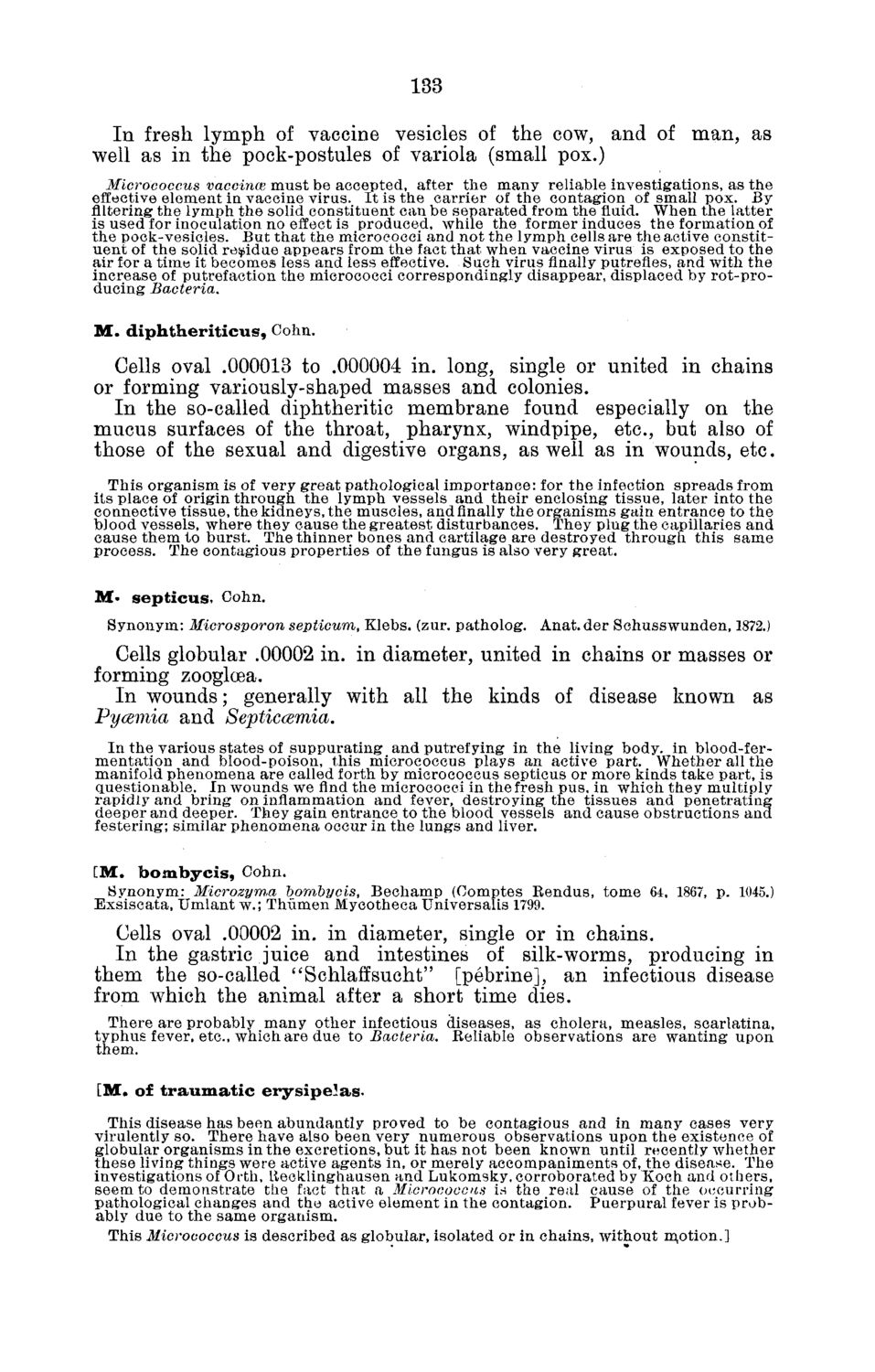| |
| |
Caption: Board of Trustees Minutes - 1882
This is a reduced-resolution page image for fast online browsing.

EXTRACTED TEXT FROM PAGE:
133 In fresh lymph of vaccine vesicles of the cow, and of man, as well as in the pock-postules of variola (small pox.) Micrococcus vaccinae must be accepted, after the many reliable investigations, as the effective element in vaccine virus. It is the carrier of the contagion of small pox. By filtering the lymph the solid constituent can be separated from the fluid. When the latter is used for inoculation no effect is produced, while the former induces the formation of the pock-vesicles. But that the micrococci and not the lymph cells are the active constituent of the solid residue appears from the fact that when vaccine virus is exposed to the air for a time it becomes less and less effective. Such virus finally putrefies, and with the increase of putrefaction the micrococci correspondingly disappear, displaced by rot-producing Bacteria. M . d i p h t h e r i t i c u s , Cohn. Cells oval .000013 to .000004 in. long, single or united in chains or forming variously-shaped masses and colonies. In the so-called diphtheritic membrane found especially on the mucus surfaces of the throat, pharynx, windpipe, etc., but also of those of the sexual and digestive organs, as well as in wounds, etc. This organism is of very great pathological importance: for the infection spreads from its place of origin through the lymph vessels and their enclosing tissue, later into the connective tissue, the kidneys, the muscles, and finally the organisms gain entrance to the blood vessels, where they cause the greatest disturbances. They plug the capillaries and cause them to burst. The thinner bones and cartilage are destroyed through this same process. The contagious properties of the fungus is also very great. M- s e p t i c u s , Cohn. Synonym: Microsporon septicum, Klebs. (zur. patholog. Anat. der Sehusswunden, 1872.) Cells globular .00002 in. in diameter, united in chains or masses or forming zoogloea. In wounds; generally with all the kinds of disease known as Pycemia and Septicemia. In the various states of suppurating and putrefying in the living body, in blood-fermentation and blood-poison, this micrococcus plays an active part. Whether all the manifold phenomena are called forth by micrococcus septicus or more kinds take part, is questionable. In wounds we find the micrococci in the fresh pus, in which they multiply rapidly and bring on inflammation and fever, destroying the tissues and penetrating deeper and deeper. They gain entrance to the blood vessels and cause obstructions and festering; similar phenomena occur in the lungs and liver. [M. b o m b y c i s , Cohn. Synonym: Microzym.a bombycis, Bechamp (Comptes Rendus, tome 64, 1867, p. 1045.) Exsiscata, Umlant w.; Thumen Mycotheca Universalis 1799. Cells oval .00002 in. in diameter, single or in chains. In the gastric juice and intestines of silk-worms, producing in them the so-called "Schlaffsucht" [pebrine], an infectious disease from which the animal after a short time dies. There are probably many other infectious diseases, as cholera, measles, scarlatina, typhus fever, etc., which are due to Bacteria. Reliable observations are wanting upon them. [M. of t r a u m a t i c e r y s i p e l a s This disease has been abundantly proved to be contagious and in many cases very virulently so. There have also been very numerous observations upon the existence of globular organisms in the excretions, but it has not been known until recently whether these living things were active agents in, or merely accompaniments of, the disease. The investigations of Orth, Recklinghausen and Lukomsky. corroborated by Koch and others, seem to demonstrate the fact that a Micrococcus is the real cause of the occurring pathological changes and the active element in the contagion. Puerpural fever is probably due to the same organism. This Micrococcus is described as globular, isolated or in chains, without m,otion.]
| |